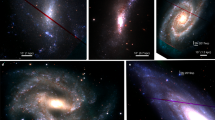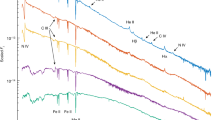Abstract
WE report observations of supernova 1987A from the maiden flight of the Gamma-Ray Imaging Spectrometer (GRIS). SN1987A was observed for a period of 11.1 hours on 1 May 1988. Line emission at 1,238 keV and continuum emission (to be reported elsewhere) from 60 to 800 keV were detected1. A gaussian line profile gives an acceptable fit to the 1,238-keV line. The best-fit parameters are: flux = 8.5 (+2.3,−2.2) x 10−4 photons cm−2 s−1 ; peak energy = 1,235.4 (+2.2, −2.4) keV; full width at half maximum = 16.3 (+6.1,−5.7)keV. As the 1,238-keV line is redshifted by 1.1 keV because of the motion of the Large Magellanic Cloud (LMC), we find no evidence for a supernova-produced red- or blueshift in the 1,238-keV line. This is to be compared with model-predicted blueshifts (in the frame of the LMC) of typically 3–4 keV (refs 2–4). Furthermore, our measured linewidfh is a factor of about two greater than the model predictions, although the discrepancy represents only two standard deviations. Our line profiles are characteristic of optically thin regions, whereas the intensity implies a mean optical depth of about 2. Fragmentation or non-spherical geometry of the supernova shell are possible explanations of the data.
This is a preview of subscription content, access via your institution
Access options
Subscribe to this journal
Receive 51 print issues and online access
$199.00 per year
only $3.90 per issue
Buy this article
- Purchase on Springer Link
- Instant access to full article PDF
Prices may be subject to local taxes which are calculated during checkout
Similar content being viewed by others
References
Barthelmy, S. et al. IAU Circ. No. 4593 (1988).
Pinto, P. A. & Woosley, S. E. Nature 333, 534–537 (1988).
Fu, A. & Arnett, W. D. Astrophys. J. (in the press).
Bussard, R. W., Burrows, A. & The, L. S. Astrophys. J. (in the press).
Dotani, T. et al. Nature 330, 230–231 (1987).
Sunyaev, R. A. et al. Sov. Astr. Lett. (in the press).
Matz, S. M. et al. Nature 331, 416–418 (1988).
Matz, S. M., Share, G. H. & Chupp, E. L. Proc. Workshop on Nuclear Spectroscopy of Astrophysical Sources (eds. Gehrels, N. & Share, G. H.) 51 (American Institute of Physics, New York, 1988).
Cook, W. R. et al. Astrophys. J. 334, L87–L90 (1988).
Sandie, W. et al. Astrophys. J. 334, L91–L94 (1988).
Wilson, R. B. et al. Proc. Workshop on Nuclear Spectroscopy of Astrophysical Sources (eds. Gehrels, N. & Share, G. H.) 73 (American Institute of Physics, New York, 1988).
Mahoney, W. A. et al. Astrophys. J. 334, L81–L85 (1988).
Gehrels, N., Leventhal, M. & MacCallum, C. J. Proc. Workshop on Nuclear Spectroscopy of Astrophysical Sources (eds. Gehrels, N. & Share, G. H.) 66 (American Institute of Physics, New York, 1988).
Gehrels, N., MacCallum, C. J. & Leventhal, M. Astrophys. J. 320, L19–L22 (1987).
Chan, K. W. & Lingenfelter, R. E. Astrophys. J. 318, L51–L55 (1987).
Woosley, S. E., Pinto, P. A., Martin, P. G. & Weaver, T. A. Astrophys. J. 318, 664–673 (1987).
Teegarden, B. J. et al. Proc. 19th Int. Cosmic Ray Conf. 1, 213–217 (1985).
Tueller, J. et al. Proc. Workshop on Nuclear Spectroscopy of Astrophysical Sources (eds. Gehrels, N. & Share, G. H.) 439 (American. Institute of Physics, New York, 1988).
Bevington, P. R. Data Reduction and Error Analysis for the Physical Sciences 235–241 (McGraw-Hill, New York, 1969).
Lampton, M., Margon, B. & Bowyer, S. Astrophys. J. 208, 177–190 (1976).
Avni, Y. Astrophys. J. 210, 642–646 (1976).
Pinto, P. A. & Woosley S. E. Astrophys. J. 329, 820–830 (1988).
Woosley, S. E., Pinto, P. A. & Ensman, L. Astrophys. J. 324, 466–489 (1988).
Shigeyama, T., Nomoto, K. & Hashimoto, M. Astr. Astrophys. 196, 141–148 (1988).
Grebenev, S. & Sunyaev, R. Sov. Astr. Lett. 13, 945–953 (1987).
Shibazaki, N. Ebisuzaki, T. Astrophys. J. 327, L9–L12 (1988).
Kumagai, S. et al. Astr. Astrophys. Lett 197, 11 (1988).
Tuohy I. R. & Dopita, M. A. Astrophys. J. 268, 11–15 (1983).
Markert, T. H., Canizares, C. R., Clark, G. W. & Winkler, P. F. Astrophys. J. 268, 134–144 (1983).
Author information
Authors and Affiliations
Rights and permissions
About this article
Cite this article
Teegarden, B., Barthelmy, S., Gehrels, N. et al. Resolution of the 1,238-keV γ-ray line from supernova 1987A. Nature 339, 122–123 (1989). https://doi.org/10.1038/339122a0
Received:
Accepted:
Issue Date:
DOI: https://doi.org/10.1038/339122a0
This article is cited by
-
A 12.4-day periodicity in a close binary system after a supernova
Nature (2024)
-
Nucleosynthesis in Supernovae
Space Science Reviews (2018)
-
Cobalt-56 γ-ray emission lines from the type Ia supernova 2014J
Nature (2014)
-
Supernova remnants: the X-ray perspective
The Astronomy and Astrophysics Review (2012)
-
Detection of high-velocity 26AI towards the Galactic Centre
Nature (1996)
Comments
By submitting a comment you agree to abide by our Terms and Community Guidelines. If you find something abusive or that does not comply with our terms or guidelines please flag it as inappropriate.



